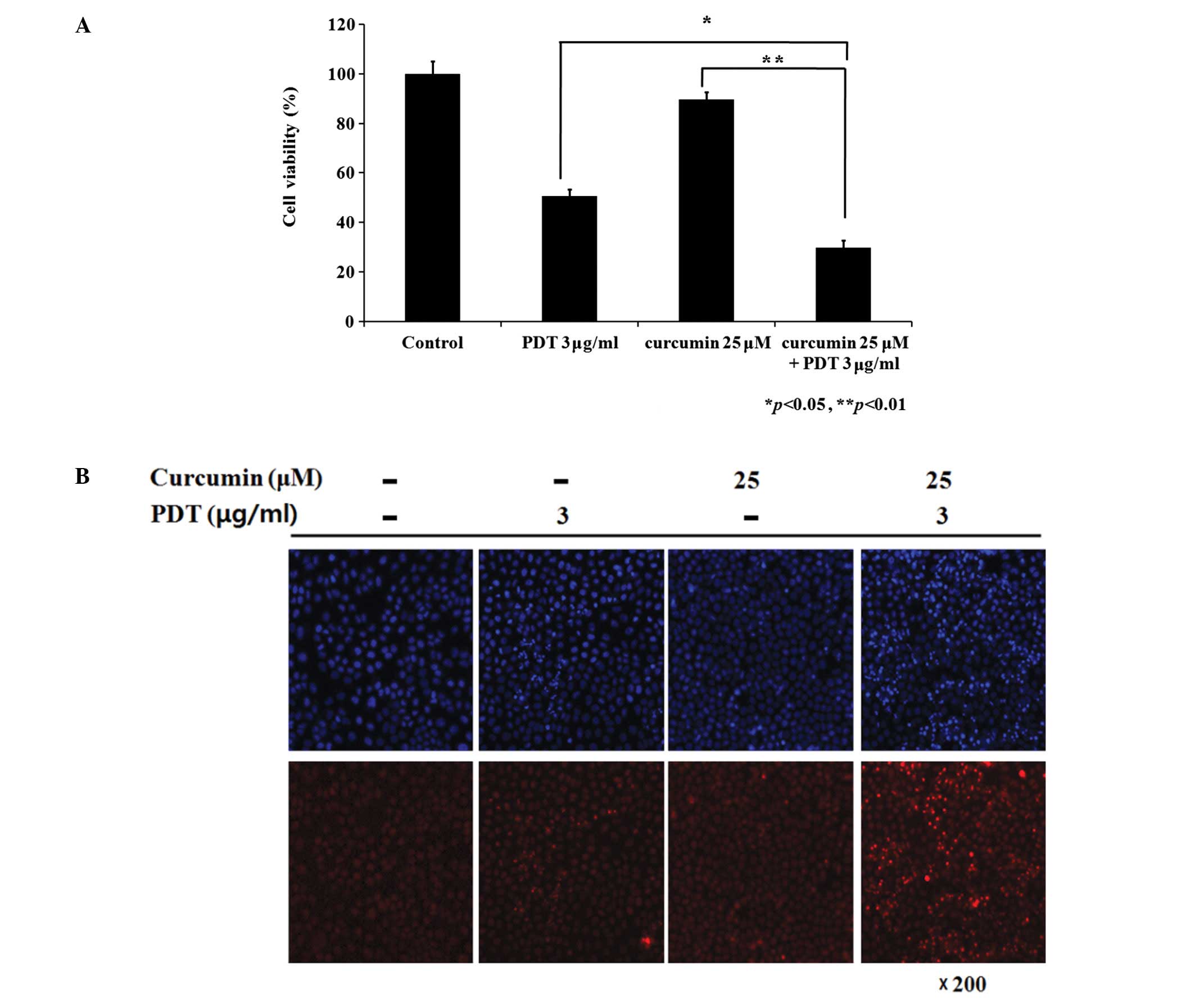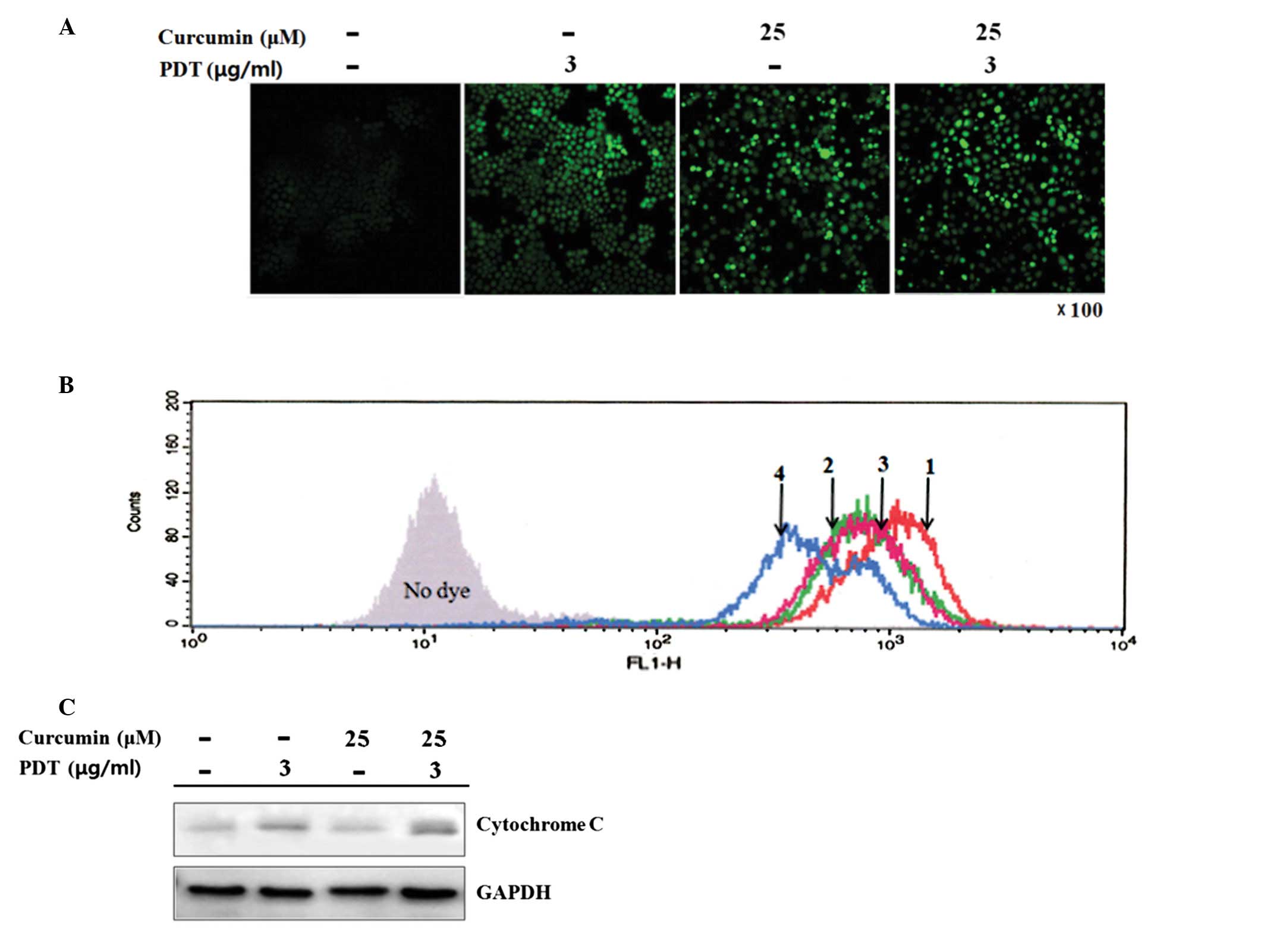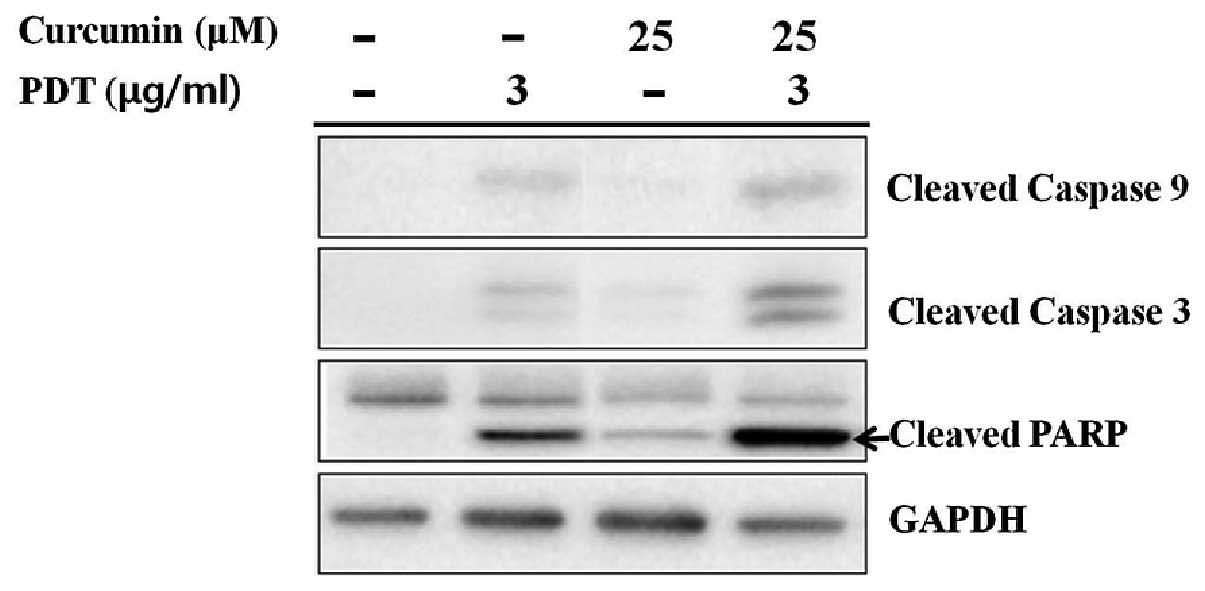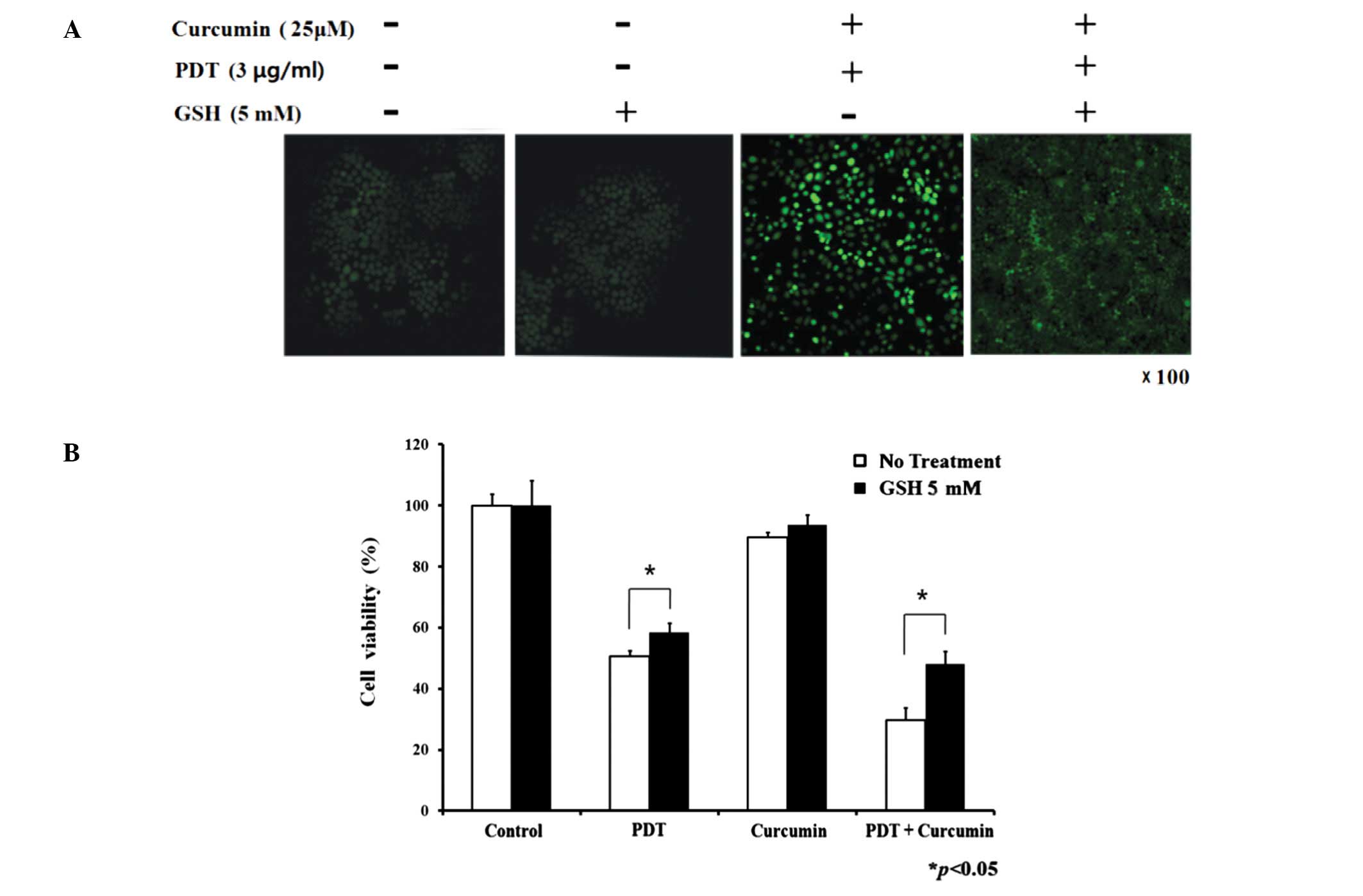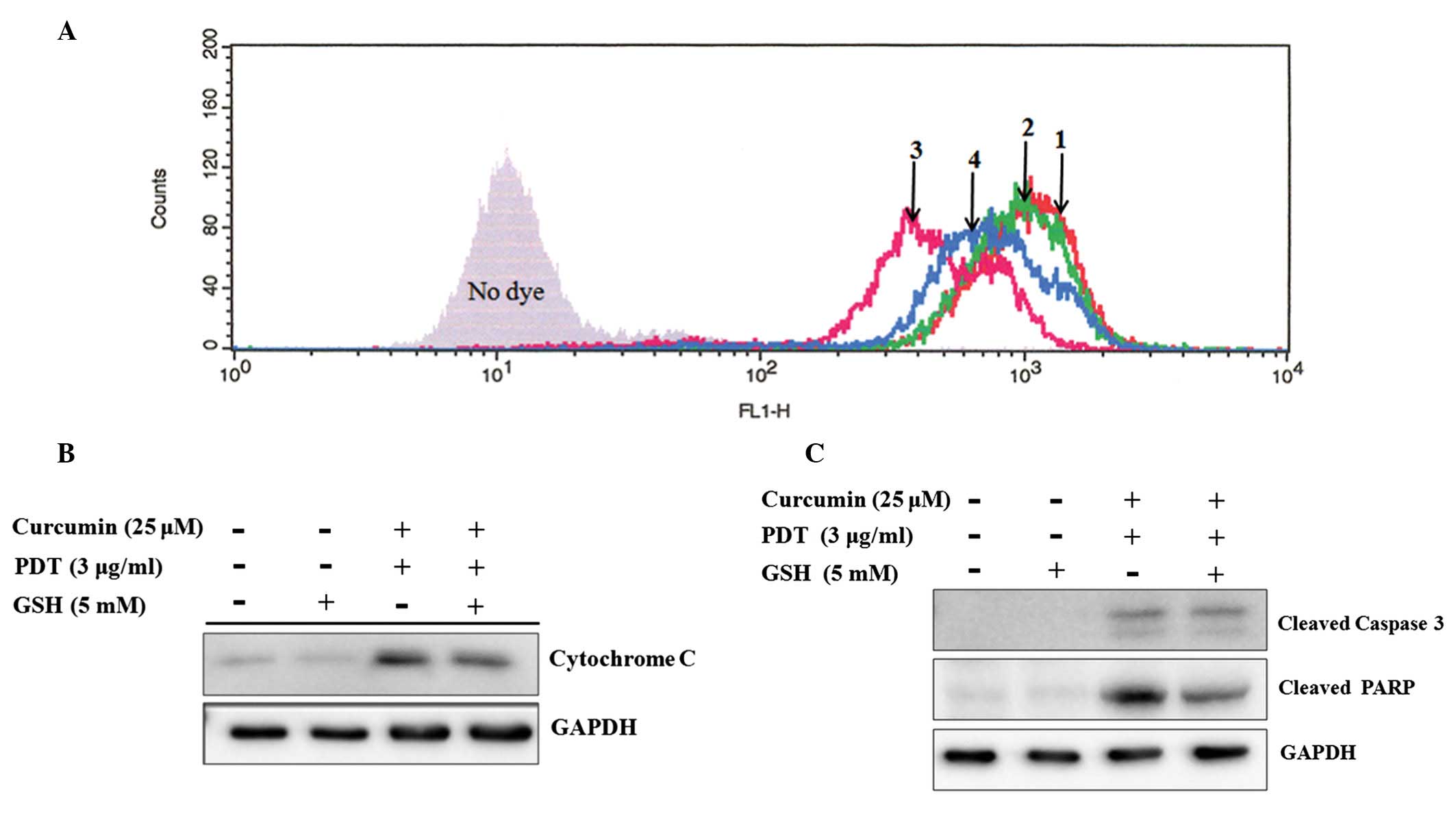|
1.
|
Dougherty TJ, Gomer CJ, Henderson BW, et
al: Photodynamic therapy. J Natl Cancer Inst. 90:889–905. 1998.
View Article : Google Scholar
|
|
2.
|
Saczko J, Mazurkiewicz M, Chwilkowska A,
et al: Intracellular distribution of Photofrin in malignant and
normal endothelial cell lines. Folia Biol (Praha). 53:7–12.
2007.PubMed/NCBI
|
|
3.
|
Hopper C: Photodynamic therapy: a clinical
reality in the treatment of cancer. Lancet Oncol. 1:212–219. 2000.
View Article : Google Scholar : PubMed/NCBI
|
|
4.
|
Yamaguchi S, Tsuda H, Takemori M, et al:
Photodynamic therapy for cervical intraepithelial neoplasia.
Oncology. 69:110–116. 2005. View Article : Google Scholar : PubMed/NCBI
|
|
5.
|
Copper MP, Triesscheijn M, Tan IB,
Ruevekamp MC and Stewart FA: Photodynamic therapy in the treatment
of multiple primary tumours in the head and neck, located to the
oral cavity and oropharynx. Clin Otolaryngol. 32:185–189. 2007.
View Article : Google Scholar
|
|
6.
|
Buytaert E, Dewaele M and Agostinis P:
Molecular effectors of multiple cell death pathways initiated by
photodynamic therapy. Biochim Biophys Acta. 1776:86–107.
2007.PubMed/NCBI
|
|
7.
|
Lu Y, Jiao R, Chen X, Zhong J, Ji J and
Shen P: Methylene blue-mediated photodynamic therapy induces
mitochondria-dependent apoptosis in HeLa cell. J Cell Biochem.
105:1451–1460. 2008. View Article : Google Scholar : PubMed/NCBI
|
|
8.
|
Moor AC: Signaling pathways in cell death
and survival after photodynamic therapy. J Photochem Photobiol B.
57:1–13. 2000. View Article : Google Scholar : PubMed/NCBI
|
|
9.
|
Niedre M, Patterson MS and Wilson BC:
Direct near-infrared luminescence detection of singlet oxygen
generated by photodynamic therapy in cells in vitro and tissues in
vivo. Photochem Photobiol. 75:382–391. 2002. View Article : Google Scholar : PubMed/NCBI
|
|
10.
|
Ding X, Xu Q, Liu F, et al:
Hematoporphyrin monomethyl ether photodynamic damage on HeLa cells
by means of reactive oxygen species production and cytosolic free
calcium concentration elevation. Cancer Lett. 216:43–54. 2004.
View Article : Google Scholar
|
|
11.
|
Surh YJ: Cancer chemoprevention with
dietary phytochemicals. Nat Rev Cancer. 3:768–780. 2003. View Article : Google Scholar : PubMed/NCBI
|
|
12.
|
Rahman I, Biswas SK and Kirkham PA:
Regulation of inflammation and redox signaling by dietary
polyphenols. Biochem Pharmacol. 72:1439–1452. 2006. View Article : Google Scholar : PubMed/NCBI
|
|
13.
|
Choudhuri T, Pal S, Agwarwal ML, Das T and
Sa G: Curcumin induces apoptosis in human breast cancer cells
through p53-dependent Bax induction. FEBS Lett. 512:334–340. 2002.
View Article : Google Scholar : PubMed/NCBI
|
|
14.
|
Karmakar S, Banik NL and Ray SK: Curcumin
suppressed anti-apoptotic signals and activated cysteine proteases
for apoptosis in human malignant glioblastoma U87MG cells.
Neurochem Res. 32:2103–2113. 2007. View Article : Google Scholar : PubMed/NCBI
|
|
15.
|
Aggarwal S, Takada Y, Singh S, Myers JN
and Aggarwal BB: Inhibition of growth and survival of human head
and neck squamous cell carcinoma cells by curcumin via modulation
of nuclear factor-kappaB signaling. Int J Cancer. 111:679–692.
2004. View Article : Google Scholar : PubMed/NCBI
|
|
16.
|
Rashmi R, Kumar S and Karunagaran D: Human
colon cancer cells lacking Bax resist curcumin-induced apoptosis
and Bax requirement is dispensable with ectopic expression of Smac
or downregulation of Bcl-XL. Carcinogenesis. 26:713–723. 2005.
View Article : Google Scholar : PubMed/NCBI
|
|
17.
|
Liu HL, Chen Y, Cui GH and Zhou JF:
Curcumin, a potent anti-tumor reagent, is a novel histone
deacetylase inhibitor regulating B-NHL cell line Raji
proliferation. Acta Pharmacol Sin. 26:603–609. 2005. View Article : Google Scholar : PubMed/NCBI
|
|
18.
|
Shishodia S, Chaturvedi MM and Aggarwal
BB: Role of curcumin in cancer therapy. Curr Probl Cancer.
31:243–305. 2007. View Article : Google Scholar : PubMed/NCBI
|
|
19.
|
Park K and Lee JH: Photosensitizer effect
of curcumin on UVB-irradiated HaCaT cells through activation of
caspase pathways. Oncol Rep. 17:537–540. 2007.PubMed/NCBI
|
|
20.
|
Dujic J, Kippenberger S, Hoffmann S, et
al: Low concentrations of curcumin induce growth arrest and
apoptosis in skin keratinocytes only in combination with UVA or
visible light. J Invest Dermatol. 127:1992–2000. 2007. View Article : Google Scholar : PubMed/NCBI
|
|
21.
|
Dursun B, He Z, Somerset H, Oh DJ, Faubel
S and Edelstein CL: Caspases and calpain are independent mediators
of cisplatin-induced endothelial cell necrosis. Am J Physiol Renal
Physiol. 291:F578–F587. 2006. View Article : Google Scholar : PubMed/NCBI
|
|
22.
|
Chung PS, He P, Shin JI, Hwang HJ, Lee SJ
and Ahn JC: Photodynamic therapy with 9-hydroxypheophorbide alpha
on AMC-HN-3 human head and neck cancer cells: induction of
apoptosis via photoactivation of mitochondria and endoplasmic
reticulum. Cancer Biol Ther. 8:1343–1351. 2009. View Article : Google Scholar : PubMed/NCBI
|
|
23.
|
Gomer CJ, Ferrario A, Luna M, Rucker N and
Wong S: Photodynamic therapy: combined modality approaches
targeting the tumor microenvironment. Lasers Surg Med. 38:516–521.
2006. View Article : Google Scholar : PubMed/NCBI
|
|
24.
|
Sarkar FH and Li YW: Targeting multiple
signal pathways by chemopreventive agents for cancer prevention and
therapy. Acta Pharmacol Sin. 28:1305–1315. 2007. View Article : Google Scholar : PubMed/NCBI
|
|
25.
|
Bush JA, Cheung KJ Jr and Li G: Curcumin
induces apoptosis in human melanoma cells through a Fas
receptor/caspase-8 pathway independent of p53. Exp Cell Res.
271:305–314. 2001. View Article : Google Scholar : PubMed/NCBI
|
|
26.
|
Chan WH, Wu CC and Yu JS: Curcumin
inhibits UV irradiation-induced oxidative stress and apoptotic
biochemical changes in human epidermoid carcinoma A431 cells. J
Cell Biochem. 90:327–338. 2003. View Article : Google Scholar : PubMed/NCBI
|
|
27.
|
Chan WH and Wu HJ: Anti-apoptotic effects
of curcumin on photosensitized human epidermal carcinoma A431
cells. J Cell Biochem. 92:200–212. 2004. View Article : Google Scholar : PubMed/NCBI
|
|
28.
|
Thannickal VJ and Fanburg BL: Reactive
oxygen species in cell signaling. Am J Physiol Lung Cell Mol
Physiol. 279:L1005–L1028. 2000.PubMed/NCBI
|
|
29.
|
Hirsch T, Marchetti P, Susin SA, et al:
The apoptosis-necrosis paradox. Apoptogenic proteases activated
after mitochondrial permeability transition determine the mode of
cell death. Oncogene. 15:1573–1581. 1997. View Article : Google Scholar
|
|
30.
|
Kinzler I, Haseroth E, Hauser C and Ruck
A: Role of mitochondria in cell death induced by Photofrin-PDT and
ursodeoxycholic acid by means of SLIM. Photochem Photobiol Sci.
6:1332–1340. 2007. View Article : Google Scholar : PubMed/NCBI
|
|
31.
|
Roberts WG, Liaw LH and Berns MW: In vitro
photosensitization II. An electron microscopy study of cellular
destruction with mono-L-aspartyl chlorin e6 and photofrin II.
Lasers Surg Med. 9:102–108. 1989. View Article : Google Scholar : PubMed/NCBI
|
|
32.
|
Lam M, Oleinick NL and Nieminen AL:
Photodynamic therapy-induced apoptosis in epidermoid carcinoma
cells. Reactive oxygen species and mitochondrial inner membrane
permeabilization. J Biol Chem. 276:47379–47386. 2001. View Article : Google Scholar
|
|
33.
|
Budihardjo I, Oliver H, Lutter M, Luo X
and Wang X: Biochemical pathways of caspase activation during
apoptosis. Annu Rev Cell Dev Biol. 15:269–290. 1999. View Article : Google Scholar : PubMed/NCBI
|
|
34.
|
Price M, Terlecky SR and Kessel D: A role
for hydrogen peroxide in the pro-apoptotic effects of photodynamic
therapy. Photochem Photobiol. 85:1491–1496. 2009. View Article : Google Scholar : PubMed/NCBI
|















